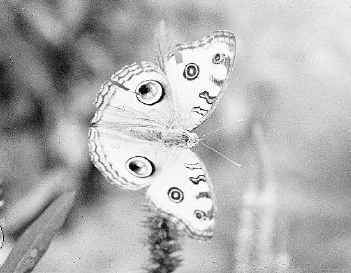|
Sci Tech
Wing patterns, key to
morphological evolution

The patterns on butterfly wings reveal much about how the
shapes, sizes and colours of specific organisms have evolved.
THE BEAUTIFUL patterns on butterfly wings are emerging as
exceptional model systems that may reveal much about how the shapes,
sizes and colours of specific organisms have evolved, a type of study
called morphological evolution, according to the authors of the paper
featured in Trends in Ecology and Evolution.
Butterfly wing patterns as possibly the best
animal system for understanding the developmental and genetic processes
that produce morphological variation in nature. The next step in understanding the genetics
of butterfly wing patterns, researchers note, is development of the
first transgenic butterfly — a butterfly in which gene expression is
manipulated to see if certain genes control colour pattern — an effort
that is underway. Butterfly wing patterns are a very amenable
system for studying morphological evolution because they develop on a
two-dimensional, epidermal surface made up of tiny scales, each of
which produces only one pigment .
While Drosophila, the common fruit fly,
traditionally has been the model system of choice for genetic and
developmental biology studies, mostly carried out in the laboratory,
the butterfly provides an exciting opportunity to connect genetic
changes with important ecological and evolutionary processes that mould
variation in natural populations. Tiny, nearly invisible differences among
different species of Drosophila have become important subjects of study
for biologists, the ecological importance being of some of these slight
differences. On the other hand, the striking variation of
wing patterns of butterflies has a clear function in the wild.
Researchers noted that the differences in wing patterns differentiate
one species of butterfly from another and are used by males and females
to determine with which individuals to mate. They also have been shown to serve an
adaptive purpose, as demonstrated by numerous studies focusing on
seasonal changes in wing coloration of individuals in a species. For instance, the darker wing patterns that
show up in butterflies that emerge in the spring serve to warm up the
butterfly faster, whereas butterflies that emerge in the summer have
lighter colours. Also, many of the butterflies that emerge
during the wet season in the tropics have very large, conspicuous marks
on their wings. These markings deflect the attacks of predators while
the butterflies are actively finding mates and laying eggs, while the
dry-season cohorts are very cryptic, trying to blend in with their
environment and not attract any attention from predators until the
rains arrive again. The researchers then will be able to test
whether genes that seem to be involved in colour pattern formation
actually are important in directing the production of different
pigments. A transgenic system is needed to test the
causal involvement of genes that have already been shown through their
suggestive expression patterns to be involved in colour pattern
formation. Even more important, it will allow
researchers to figure out the regulatory regions of these genes that
are turning them `on' in a particular spatial area on the wing.
Send this article to Friends by
E-Mail
Sci Tech
|

